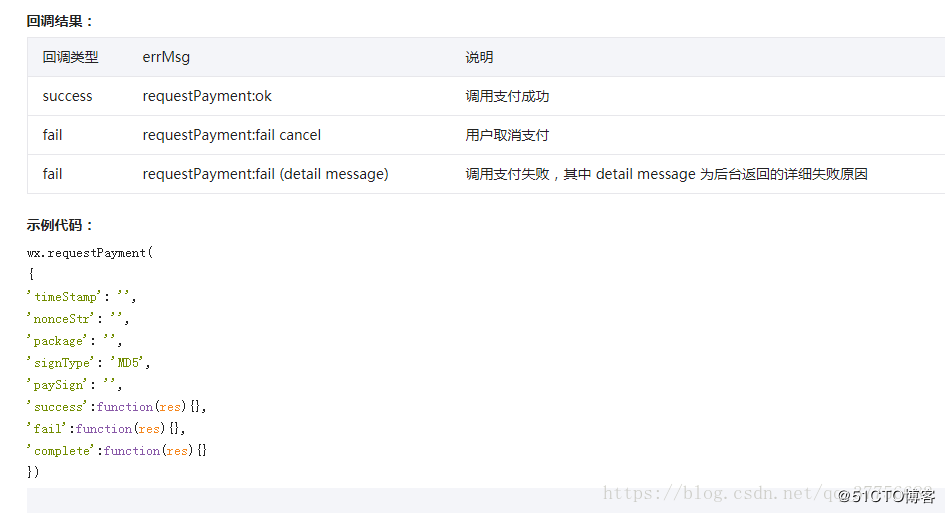微信小程序的java支付開發(fā)一直是一塊坑,網(wǎng)上的教程也是琳瑯滿目。筆者六月的時候接觸到了微信的小程序開發(fā)摸到了微信支付方面的東西,騰訊的官方文檔也是一言難盡很多地方看不懂,而且官方也沒有提供java的示范導致java做微信支付不得不自己踩坑。現(xiàn)在我把自己微信支付開發(fā)的步驟和代碼都在下面展示出來,希望有沒有做出來的朋友不要心急跟著我的步驟走就沒問題。
第一步:首先微信支付的話只能是企業(yè)的開發(fā)賬戶才能使用的如果你是個人開發(fā)者是無法開通微信支付的。我們首先拿到賬號,然后拿到微信支付相關的商戶號和商戶支付密鑰,這些東西公司都會提供。有了這些以后就可以進行開發(fā)了。
|
1
2
3
4
5
6
7
8
9
|
public class configure { //商戶支付密鑰 private static string key = "****************************"; //小程序id private static string appid = "***************"; //商戶號 private static string mch_id = "*********"; //小程序密鑰 private static string secret = "********************"; |
我把開發(fā)者賬號和商戶號都放在了一個工具類方便在后面的調(diào)用。
第二步:做支付要先獲取到用戶的openid這是一個很重要的參數(shù)你必須要拿到的東西不然就無法完成支付。下面是我獲取用戶的openid的代碼。
|
1
2
3
4
5
6
7
8
9
10
|
protected void doget(httpservletrequest request, httpservletresponse response) throws servletexception, ioexception { string code = request.getparameter("code"); httpget httpget = new httpget("https://api.weixin.qq.com/sns/jscode2session?appid="+configure.getappid()+"&secret="+configure.getsecret()+"&js_code="+code+"&grant_type=authorization_code"); //設置請求器的配置 httpclient httpclient = httpclients.createdefault(); httpresponse res = httpclient.execute(httpget); httpentity entity = res.getentity(); string result = entityutils.tostring(entity, "utf-8"); response.getwriter().append(result); } |
第三步:獲取到用戶的openid之后我們就要進行下單。簡單來說要把微信支付所需要的參數(shù)都準備好然后給到官方提供的api。這些東西在官方的文檔里面各位可以去查閱。下面是我傳遞參數(shù)的代碼:
|
1
2
3
4
5
6
7
8
9
10
11
12
13
14
15
|
string openid = request.getparameter("openid");int totalfee=integer.parseint(request.getparameter("totalfee"));//獲取支付金額string out_trade_no=randomstringgenerator.getrandomstringbylength(32);//商戶訂單號orderinfo order = new orderinfo();order.setappid(configure.getappid());order.setmch_id(configure.getmch_id());order.setnonce_str(randomstringgenerator.getrandomstringbylength(32));order.setbody("測試");order.setout_trade_no(out_trade_no);order.settotal_fee(totalfee);order.setspbill_create_ip("***.***.***.**");order.setnotify_url("https://www.see-source.com/weixinpay/payresult");order.settrade_type("jsapi");order.setopenid(openid);order.setsign_type("md5"); |
可以看到上面的傳遞的參數(shù)中有需要支付的金額、和隨機生成的32位商戶訂單號、以及開發(fā)者的appid和支付說明支付的ip地址這些參數(shù)我們想辦法都拿到之后是否就能丟給官方api呢?當然還不是,往下看第四步。
第四步:我們拿到了參數(shù)之后能否直接給到api呢?微信支付出于安全考慮參數(shù)需要進行加密之后發(fā)送給微信支付api。我們得把剛剛拿到的參數(shù)進行簽名加密,我這里用到的是md5的加密方式,代碼如下:
|
1
2
3
4
5
6
7
8
9
10
11
12
13
14
15
16
17
18
19
20
21
22
23
24
25
|
try { string repay_id = request.getparameter("repay_id"); signinfo signinfo = new signinfo(); signinfo.setappid(configure.getappid()); long time = system.currenttimemillis()/1000; signinfo.settimestamp(string.valueof(time)); signinfo.setnoncestr(randomstringgenerator.getrandomstringbylength(32)); signinfo.setrepay_id("prepay_id="+repay_id); signinfo.setsigntype("md5"); //生成簽名 string sign = signature.getsign(signinfo); jsonobject json = new jsonobject(); json.put("timestamp", signinfo.gettimestamp()); json.put("noncestr", signinfo.getnoncestr()); json.put("package", signinfo.getrepay_id()); json.put("signtype", signinfo.getsigntype()); json.put("paysign", sign); l.info("-------再簽名:"+json.tojsonstring()); response.getwriter().append(json.tojsonstring()); } catch (exception e) { // todo auto-generated catch block e.printstacktrace(); l.error("-------", e); } |
|
1
2
3
4
5
6
7
8
9
10
11
12
13
14
15
16
17
18
19
20
21
22
23
24
25
26
27
28
|
public static string getsign(object o) throws illegalaccessexception { arraylist<string> list = new arraylist<string>(); @suppresswarnings("rawtypes") class cls = o.getclass(); field[] fields = cls.getdeclaredfields(); for (field f : fields) { f.setaccessible(true); if (f.get(o) != null && f.get(o) != "") { string name = f.getname(); xstreamalias anno = f.getannotation(xstreamalias.class); if(anno != null) name = anno.value(); list.add(name + "=" + f.get(o) + "&"); } } int size = list.size(); string [] arraytosort = list.toarray(new string[size]); arrays.sort(arraytosort, string.case_insensitive_order); stringbuilder sb = new stringbuilder(); for(int i = 0; i < size; i ++) { sb.append(arraytosort[i]); } string result = sb.tostring(); result += "key=" + configure.getkey(); system.out.println("簽名數(shù)據(jù):"+result); result = md5util.md5encode(result,"utf-8").touppercase(); return result; } |
到這一步就已經(jīng)支付完成了。


通過官方api返回的回調(diào)類型來判斷支付是否成功。
只要大家按照步驟來就可以實現(xiàn),以上就是本文的全部內(nèi)容,希望對大家的學習有所幫助,也希望大家多多支持服務器之家。
原文鏈接:http://blog.51cto.com/13981400/2309067















